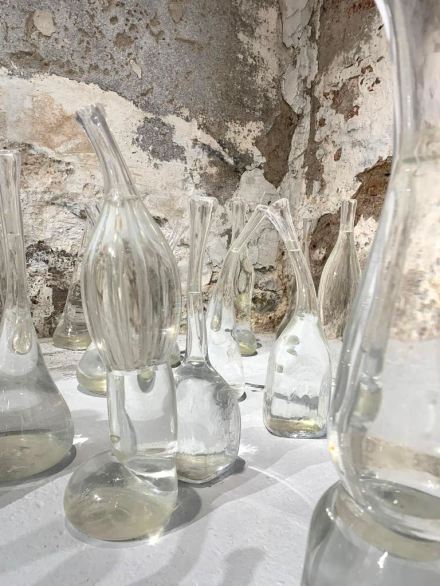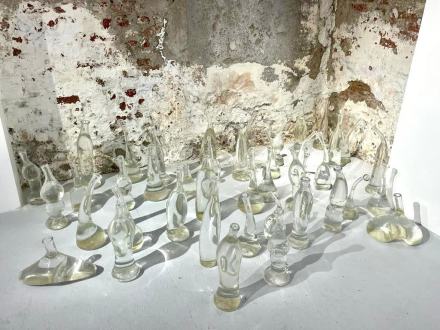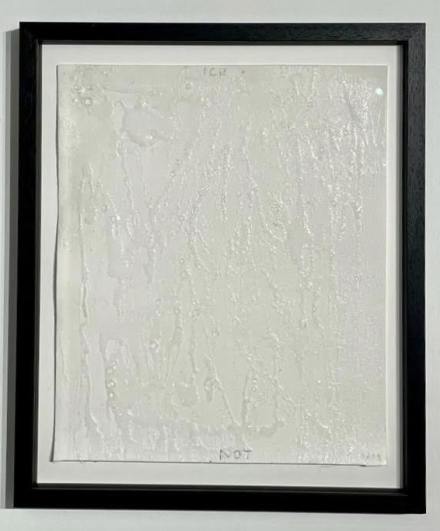
Not Vital at Alma Zevi (Installation View)
On view at ALMA ZEVI through November 6 is SNOW & WATER & ICE by Swiss artist Not Vital. As Vital’s first solo exhibition at the Venice gallery, it coincides with the artist’s solo show in Andrea Palladio’s Abbazia di San Giorgio Maggiore, organized by the Benedicti Claustra Onlus, on the occasion of this year’s Architecture Biennale.

Not Vital at Alma Zevi (Installation View)
For the works on display, Vital employed ceramic, insulating tape, silicone, and even foam to create lifelike tableaux that cross the threshold of representation into immanence. Droplets of snow seem to emerge from the canvas as if the darting from the sky in a blizzard of grey, invoking the Grisons mountain range where Vital grew up, aptly named for its vernacular monochrome that alternates in shades of grey and white throughout the year. Mountain (2017), for instance returns to the realm of rendering, but only just: the silicone, snowcapped outline it emanates is nearly imperceptible against the aluminum foil tape. Walking around the work one must focus to keep the dimensions in view, insofar as the silicone’s encrustations depict a mountain, rather than veering towards the abstract or informe.

Not Vital at Alma Zevi (Installation View)
The process through which Vital creates his works evokes, in unexpected ways, the morphology of glaciers. Icecaps, for instance, form over extended timeframes in which lightweight snow gradually compresses and re-crystallizes into minute granules under accumulated weight. This is, by definition, a slow process that inheres the duration of geologic timescales. Vital discovered a similar process with White Line (1970), where his daily walk to school during the thawing spring revealed a line of ice that had packed beneath his repeated treks in the snow.
Other processes of morphology can also be found in this show, such as the blown-glass bottles of Val Sinestra (2019). For this exhibition, the bottles are brimming with Venetian lagoon water. This work reconciles, in alchemistic ways, the representation of ice with its other form. As the winter solstice nears, the dichotomy of water within glass is altogether timely. The staging of a transformation that is to come when the show closes and the water is, presumably, re-poured into the canals. Should this year bring the incredibly rare phenomenon of the canals freezing (recorded only twice in the auspicious years of 1929 and 2012), Vital’s prophesy in glass, as I see it, may be realized yet.

Not Vital at Alma Zevi (Installation View)
To commemorate the simultaneity of these exhibitions, Art Observed had the pleasure of interviewing Vital to learn more about his history creating works in Venice, his architectural approach to sculpture, and how his longstanding interest in ice stems from his alpine childhood skipping school to make “habitats†like treehouses and snow forts.
AO: Tell me about the inspiration behind your exhibition at ALMA ZEVI Venice.
VITAL: When I first went in to Venice in the late 1990s I wanted to make sculptures out of glass, and that wasn’t an easy thing to do. I was lucky to work with Pino Signoretto who is the big master on Murano. The first thing I asked him was: “Can you make ice?†And he said: “Well, let me think about it, I’ll tell you tomorrow.†In the end, it turned out he was indeed able to make glass that looked like ice. I made a few sculptures with Signoretto – one of them, entitled 700 Snowballs (2001), is an installation of 700 snowballs enclosed in transparent ice, both the snowball and the ice being made out of glass. 700 Snowballs was exhibited in several venues and museums, including when Alma showed it in Venice in 2013 in collaboration with Stanze del Vetro and Fondazione Giorgio Cini on the Island of San Giorgio Maggiore. The installation is beautiful and light; it’s the closest I could come to transforming a snowball into something else. With Signoretto I also built a small house (Glass House, 2002), which is now installed in my Sculpture Park in Sent.
My current exhibition with Alma was a great chance to work with glass again and to spend time in Venice.

Not Vital at Alma Zevi (Installation View)
ZEVI: I think there’s an interesting connection between the mountain lakes of the Engadin, the canals of Venice, and the changes between ice and snow. Obviously, in Venice you always feel the presence of water. And so, with this indoor piece of sculpture – Val Sinestra – you offer the idea of water in it’s different states, existing inside and outside, being mobile and immobile. The other works we are showing in the gallery are also be connected to snow and ice, and consist of works on paper and painting. I think bringing that experience of nature into the gallery is interesting and connects to many important aspects of your practice.
AO: Can you talk about your childhood spent in the mountains of the Engadin in Switzerland? Did it have a deep impact on your work?
VITAL: When I was three years old and my brother was in his first year of school, we dug a tunnel in the snow which led from our house down to the street. I simply stayed in this tunnel. Somehow, this was the first habitat I built. And I thought, “This is great. It’s better than going home!â€
The feeling I experienced in this decisive moment stayed with me. I never forgot that feeling, and that’s why I went on and built all these habitats all around the world. Just recently, I was in Indonesia to visit the house I am building there and to spend time in it. It doesn’t have a toilet, and it doesn’t have electricity. I love that.
ZEVI: It seems to me that the feeling you describe around those first habitats is really connected to a feeling of freedom and of autonomy. It’s like you’ve continued that from your childhood into adulthood and your 50-year career working as an artist. It’s like a red line: the idea of freedom and using materials to create different universes that don’t ‘abide by rules’.
AO: Speaking of lines, let’s talk about some of the first works that you made. I am particularly interested in the piece called White Line (1970). What strikes me about this work is its process of discovery. In hindsight, now that it has been neatly catalogued within your œuvre, the work appears performative and durational. But of course, in 1971, the work was somewhat of a revelation unto you. How did this come about?
VITAL: I made White Line in 1970 and it was one of my very first works. That winter, I was up near the village of Susch, which is a village not far from Sent. I was walking up and down the same path for so long until the snow underneath my feet was hard and compressed. And when the rest of the snow eventually melted away, this path I had created stayed as it was almost as compact and resistant as ice. So you could see this white line after the rest of the snow had melted.
ZEVI: And by walking, you play with the idea of a fixed materiality in White Line. Your action of walking transformed the snow into ice, and in doing so you intervened with a natural timeline.

Not Vital at Alma Zevi (Installation View)
VITAL: When I started making my first sculptures I used plaster. I didn’t realize it at the time, but I later understood that I might have chosen plaster because it was somewhat similar to the snow I was so familiar with. Not only because of the color, but also because of its malleability. I explored this similarity when I did my Snowball Walls (2005, 2006, 2015, 2016). For these installations I formed snowballs out of plaster and threw them onto a wall. I did it for different museums, such as the Victoria & Albert Museum and Yorkshire Sculpture Park.
AO: A work that seems connected to your Snowball Walls is the series of plaster mountains. Can you speak to the connection?
VITAL: I was preparing an exhibition in Milan in 2000, sitting in my natal house in Sent. I opened the window and just looked at the five magnificent mountains that are visible from the house. And then I said to myself, “I just have to make these five mountains in plaster.â€
ZEVI: The plaster seems like the perfect material for this as it has an immediacy that you might lose in another process.
VITAL: Yes, I like to work fast. And you are forced to be fast when you work with plaster as you only have five minutes before it hardens and becomes difficult to model.
ZEVI: I feel that you can see the speed at which you worked here;Â there is an urgency and you’ve left them quite rough at the base. There’s the chicken wire that you can see poking out of the bottom. I love that.
AO: What instigated this formal interest in making sculptural works around snowballs, ice, and snow sculptures in 2000-2001, such as Mias Muntognas and Piz Lischana?
VITAL: I was living in New York, but when I returned to Switzerland I realized that what I actually had been wanting to portray all along was right in front of my eyes.
The area I live in is called the Grisons, which means ‘the grey place’. The stones here are grey and so are the mountain peaks in summertime. In winter, on the other hand, they are white. And so one becomes not only accustomed to these colors, but develops a sensitivity for grey and white.
AO: I’m wondering if this resurgence of interest in ice plays into the theme of widespread glacial melting and climate change?
VITAL: I remember when I was little, a part of the mountain here fell down. It went on for days and nights. I remember the sound very well as it was a deep and distinct sound. The other day I heard it again. It’s Permafrost. Inside the mountains, the ice melts and then the rock doesn’t hold together anymore. Living here, I am aware of how nature changes.
AO: Not, you have come up with the word SCARCH to categorize your work where sculpture and architecture meet. Many of these works are on view at Hauser and Wirth Somerset. Conceptually speaking, is SCARCH more of the feeling you get in a space, rather than the direct parameters of the space?
VITAL: I would like to live in a large sculpture. I recently made a steel sculpture head of a camel head (Camel, 2018) and placed it in the grounds of my castle in Tarasp. You can actually enter the Camel head through a little door, and it’s like a different world in there, in the head of a camel. And this is precisely how my sculptures turn into architecture.
ZEVI: The Camel is a great example of your SCARCH practice, as it is so clearly interactive. I was also thinking a meeting between your work in glass and your SCARCH is the Glass House in your sculpture park, which is made of glass bricks (made in Murano). It’s fascinating because there are brick walls creating a threshold between inside and outside, yet the diffused light travels through the glass, almost dissolving that very threshold. So, I think bringing the element of glass into the discussion of SCARCH is complex, but also conceptually very interesting.
AO: We spoke about your Snowball Wall earlier – where you threw plaster against the wall. There’s again a sense of performative energy, could you dwell on this?
VITAL: We would always throw snowballs at school. We measured how far we could throw snowballs. When I think about it now, it seems like it was actually a performance. Later on, in the 1970s I went to Rome after going to Art School in Paris. I wanted to become a painter. In Rome, people would spend a lot of time on Piazza Navona, hoping that Fellini would pass by looking for some actors. There I made a circus and learned how to blow fire; a lot of performance ideas grew out of my time with the circus.
AO: I love the theme of throwing different elements over your career, first snow, then fire, and finally plaster as if performing snow. As much of your work is site-specific, involves performance or repetition, and is designed for remote, outdoor spaces, it recalls the seminal earthworks of the 1960s and 70s. However, whereas these earthen ciphers were deliberate markings in the ground, works like White Line stands apart as a marking that gradually formed over time, as I understand without your intention. If this is the case, then White Line is unique in the history of earthworks. I would like to hear your thoughts about your proximity to the Land Art movement
VITAL: I was aware of Land Art; but they don’t have so much in common with my work. What interests me is to create habitats.
I travelled to Niger in the late 1990s and created several buildings there in the subsequent ten years. This, together with the sculpture park in Sent, was the beginning of SCARCH. After I realized one of my first houses in Niger, in 2005, House to Watch the Sunset (a version of which was also on display at Hauser and Wirth Somerset), I decided to build one of these structures on every continent.
I did consider the Southwest (Utah is the most beautiful state I have ever been to in the U.S.), but there are already great works there – Nancy Holt’s Sun Tunnels (1976) and Robert Smithson’s Spiral Jetty (1970). Richard Armstrong [Director of the Solomon R. Guggenheim Foundation] said to me, “Why don’t you do this in my home state – I live in Kansas, there is nothing there, and it’s exactly in the center of America?†But I went to other places because I wanted to go far away. If you do a project in Patagonia, where I have an island in the middle of a lake, or in Tonga, where I was recently to realize another project, then it becomes like a myth. I’ve always liked this saying by Nietzsche, which can be paraphrased as, “if you really like something, even a person, if someone is your star, it’s not in front of you, it’s far away, otherwise it cannot be your star.â€
SNOW & WATER & ICEÂ is open through November 6th.
– Q. Childs
Read more:
Not Vital at Alma Zevi [Exhibition Site]



